Cannabis: the secret of maria
The first news about the healing properties of cannabis spread in the past. BC. In 2737, Emperor Sheng Nung in China pointed out in his book Pen Tsao that cannabis is good for preventing or curing pain, gout, malaria and certain diseases (Figure 1). In 1890 Sir Russel Reynolss, doctor of Queen Victoria of England, ordered a cannabis to relieve the pains of the rule.
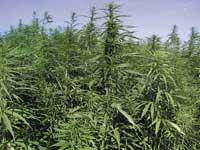
Therefore, in the first issue of The Lancet magazine, this same doctor wrote about cannabis: "... when it is pure and concerned, it is one of the most appreciated medicines we have..." Hemp came to Europe brought from Egypt by Napoleon and entered the pharmacopoeia. However, years later, after a series of studies on harmful effects, he withdrew from the global pharmacopoeia. Due to its psychoactive effects, it was used to play sports, so in 1835 Baudelaire and other artists founded the Hashichines club.
Hemp is an annual plant that, due to its sexual dimorphism, has totally different blooms between the male and the female. Hemp is found within the species Cannabis sativa and there are three different subspecies: indica, sativa and rudelaris, each with its characteristics (Figure 1). The sativa subspecies can be found worldwide, but the highest concentration of cannabinoids grows in the tropics.
Indica
The subspecies is a shrub plant located in the Himalayas, harder for the time than that born in the tropics. The structure formed by the leaves and pistils of the hemp female secretes resin, used for the formation of hashish. The subspecies Rudelaris is found in the republics of the former Soviet Union, but the concentration of cannabinoids is lower than in other subspecies.
Cannabinoids: responsible for the effects

Cannabinoids are carboxylic acids derived from Cannabis sativa and its products. The presence of cannabinoids in the plant is conditioned mainly by genetic factors, but also by the climate (light, temperature), the time of collection, sex and parts of the plant collected. In hemp there are about sixty-one cannabinoids, of which only three are responsible for psychoactive effects. The most important component, due to its psychoactive effects, is tetrahydrocannabinol P 9 (Figure 2). Other cannabinoids, such as P 8 tetrahydrocannabinol and cannabinol, have weaker psychoactive effects. However, cannabinoid produces another type of non-psychoactive effects.
The application pathways of cannabinoids are abundant and, being soluble in lipids, they quickly cross the body's membranes. Smoking is the most well-known way of consumption. Among the different forms that hemp can adopt, the most used is the resin itself ( hashish), but also the preparation with leaves and eyes of hemp ( maria) and hemp oil (with higher concentration of THC) is quite used (Figure 2).
It seems that the combustion of hemp causes raw THC acid to become free THC. This free THC is breathed along with smoke and, crossing the membranes of the pulmonary alveoli, reaches the pulmonary capillaries. From there, THC is quickly transported to the heart and directly to the brain; the process is as fast as intravenous administration. The effect appears immediately after burning and lasts little. On the other hand, the route used for the application of hemp is the oral route, since the pharmacological effects are maintained, although the absorption is variable.
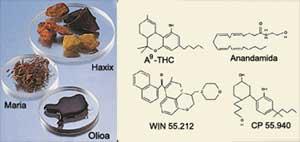
Chronic hemp intake does not alter the elimination of cannabinoids: the same amount is eliminated. In addition, due to the lipophilic characteristics mentioned above, cannabinoids have storage capacity in hydrophobic deposits such as adipose tissue. Therefore, it is possible to find metabolites in the urine analysis for several weeks. Rectal absorption is very good and the bioavailability obtained is higher than oral. In addition, in this way, the drug enters directly into the blood circulation and prevents liver metabolism.
Are cannabinoids psychoactive substances?Several studies have shown that the effects of THC are quite variable depending on the smoker and the characteristics of the drug. It depends on dosage, administration, user experience, sensitivity to psychoactive effects and smoking situations. Cannabis poisoning causes a serious imbalance between humor, understanding and motivation. However, in most cases the smoker only looks for an encouraging effect. It seems that the crab separates these stimulant effects from those caused by opiates and stimulants.
The habitual smoker perceives an encouraging effect for two hours, although it must be taken into account that the effectiveness of hemp depends on the dose. Several studies have shown that while the drug is subjected to acute effects, the user is greatly impaired cognition, perception, reaction time, learning ability and memory. In addition, the lack of coordination of body movements continues for several hours after the encouraging effect has disappeared. This disturbance is due to the inability to drive vehicles and work.
Chronic cannabis use completely modifies drug addict behavior and in complex directions such as appetite (Figure 3). Although some smokers have claimed to get more satisfying sex, it has not been scientifically confirmed. However, it has been shown that after the burning of cannabis effects appear as hallucinations, panic crisis and psychosis.
According to user surveys, 50-60% of hemp smokers have suffered more than once an anxiety crisis. These reactions are usually observed with the highest doses of oral route, since smoking allows to dominate the dose according to the perception of the effects. Moreover, the relationship between cannabis and the risk of schizophrenia has not been confirmed, but some clinical publications have shown that patients with a history of schizophrenia, if hemp is burned, psychosis can reappear more quickly.
One of the most controversial effects that cannabinoids seem to produce chronically is the syndrome of lack of motivation. It should be noted that this syndrome does not appear in diagnostic guidelines, but the term indicates well the situation of those who abandon social activities and do not show interest in school. Although a causal relationship with consumption is not shown by itself, cannabis is often considered the origin of this syndrome, especially if its use is hard. Nor has hemp been ensured to damage neurons or produce definitive functional changes. In fact, studies in clinical trials with laboratory and human animals have shown that abandoning cannabinoids is a progressive recovery from damage to the learning process in a few weeks.
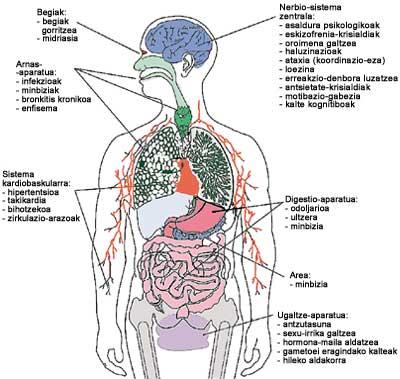
In general, dependence comprises three facts: tolerance, physical dependence and psychic dependence.
Tolerance.
Tolerance consists in the disappearance of the effects that a certain drug can cause by its repeated administration. In laboratory animals it has been shown that chronic administration of certain cannabinoid agonists produces tolerance to analgesia, inhibition of motor activity, hypothermia, etc. In humans, clinical studies have also confirmed tolerance to the pharmacological effects of THC. In addition, the development of tolerance is related to the dose of THC ingested, so as THC consumption increases tolerance.
However, it should be noted that the doses used to induce tolerance in laboratory animals are much higher than those normally used by man. In fact, the tolerance dose in animals should be 20-50 mg/kg per day and, knowing that a marijuana cigarette has between 30-60 µg of cannabinoid, a human should burn between 300 and 1,500 cigars per day in order to carry out this phenomenon. It should also be noted that the development of tolerance to cannabinoids may be responsible for both the inner cannabinoid and opioid systems.
Physical dependence.
Physical dependence is because the body gets used to working under the effects of the drug. According to several studies, after 6 days of administration of THC (20 mg/kg) to laboratory animals, once the application of this cannabinoid has ceased, a slow withdrawal syndrome is observed and the most representative clinical signs only appear after administration of the cannabinoid antagonist. It seems that this event is related to the long life cycle (time required to reach half the concentration) of THC elimination. In fact, being the less intense cannabinoid WIN 55212 agonist, a more obvious withdrawal syndrome occurs when you stop taking it.
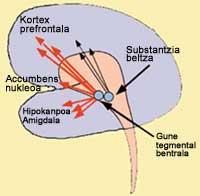
In animals, most clinical signs reflecting cannabinoid withdrawal syndrome are related to impaired movement control. Among other things, there are ataxias, shaking of the trunk, shaking of the legs, abnormal postures and decreased motor activity. It should be noted that the vegetative clinical signs (hypothermia and weight loss, for example) that appear in opioid withdrawal syndrome are not seen in the case of cannabinoids.
In humans, as in laboratory animals, a slow withdrawal syndrome is observed after 3 weeks of THC treatment. The clinical signs that appear in this case are anxiety, anorexia, insomnia and irritability and the most obvious signs appear in the first days.
Psychic dependence.
Psychic dependence on cannabinoids is the main component of dependence, since, as with alcohol, heroin and other drugs, it indicates the difficulty of freely abandoning the drug. The drug addict's urgent need to get and burn cannabis is based on a specific neurobiological root, the dopaminergic system of the CNS. However, it has been hard work to relate the influence of cannabinoids to neurotransmitter dopamine, especially in cases of cocaine, nicotine and opiates. Until knowledge of the pharmacokinetic characteristics of the CB1 receptor and cannabinoids, the whole neurobiological theory was not developed in the last decade.
At present we are quite clear that, taking behavioral and neurophysiological research as a model, cannabinoids activate the mesolinic pathway (Figure 4). This mesolinic system is called a network of rewards, as it functions as a boosting stimulus that maintains survival actions, such as food and sex. It should be noted that in the areas of this network participate not only dopamine, but also glutamate, GABA and peptide neurotransmitters. These have great importance for getting new remedies.
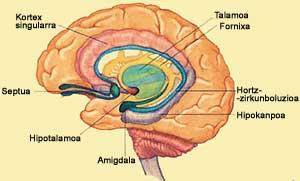
Of all the effects that cannabis can produce, the most useful and currently studied are two: the antiemetic effect and increased appetite in patients with AIDS or cancer. In fact, the synthetic derivative of THC reduces vomiting attributed to chemotherapy. This substance is not available in United States, Canada and Great Britain.
In the last decade cannabis research has increased considerably and numerous therapeutic uses have been proposed. These include analgesia, treatment of specific CNS cancer, prevention of movement alterations in degenerative diseases, decreased intraocular pressure and anticonvulsant effects.
Analgesia.
Numerous scientific publications have shown that cannabinoid agonists have an analgesic effect. This influence is mainly due to cannabinoid receptors located in the spinal cord and supra-spinal areas. It seems that the most important pending research is the combination of the analgesic effects of cannabinoids and opioids. In fact, the mechanism of action of opioid analgesia differs from that used by cannabinoids, so the administration of both in small doses would reduce unwanted effects and increase beneficial effects (analgesia).

Central nervous system tumors.
In recent years, researchers at the Complutense University of Madrid have shown that the cannabinoid THC in rats reduces the size of the brain tumor glioma. In fact, this cannabinoid prevents cell duplication by apoptosis (programmed death) caused by a substance called ceramics. In addition, THC appears to inhibit angiogenesis, the development of blood vessels needed to feed and develop the tumor.
Degenerative diseases.
The endocannabinoid system participates in movement control. In fact, in the striated body, in the CNS area related to motion control, there are many CB1 receptors. Researchers such as THC have shown that activation of the CB1 receptor is an inhibition of movement. In this sense, the knowledge that movement control is performed through the CB1 receptors has opened many avenues of research, especially in the search for new remedies in various diseases related to the motor system, such as Parkinson's disease, Huntington's korea and multiple sclerosis.
Thus, researchers have shown that in humans affected by Parkinson's disease the number of CB1 receptors is higher. Therefore, CB1 receptor antagonists would be the research topic for this disease. However, in Huntington's Korea the opposite appears to occur, that is, in the basal ganglia the number of cannabinoid receptors is lower than normal, so in this case the CB1 receptor agonists would be the most useful therapeutically. It has also been shown that in people with Alzheimer's disease this cannabinoid receptor is lower. In addition, cannabinoids have the ability to cushion painful muscle contractions that occur in multiple sclerosis. This fact has only been shown in laboratory animals, but patients with multiple sclerosis have confirmed this beneficial effect.
Intraocular pressure.
Synthetic cannabinoids appear to have the ability to lower intraocular pressure. However, synthetic cannabinoid drugs that have been tested so far produce too many unwanted effects on the beneficial ones.Epilepsy.
According to studies with laboratory animals and humans, both THC and cannabis exert anti-epileptic action on people with grand mal seizures. Also, knowing that change has no psychoactive effects, it would be interesting to do more research in this field in the future.
Cannabinoid system
In the 1980s and 1990s, when research on hemp resumed, the extraction, synthesis, metabolism, pharmacology and psychology of cannabinoids were analyzed and cannabinoid receptors were identified. There are two types of cannabinoid receptors: CB1 in the central nervous system (CNS) and CB2 in peripheral tissues.
CB receptors are associated with G proteins and the excitation of Gi/or protein adapted to CB receptors can modulate three effective systems: MAP kinase system (activated), adenilil cyclase system (inhibited) and ion channels (modified potential membrane) (lower figure). The distribution of CB1 receptors is very wide in the brain and appears to be related to the pharmacological effects that appear in the CNS after the application of cannabinoids. The highest number of receptors is found in the basal ganglia, where the aim is to control forced movements. In the hippocampus the number of CB1 is also high, which highlights the influence of cannabinoids on memory and learning processes. However, CB2 receptors are found in the immune system, liver, lungs, and kidneys.
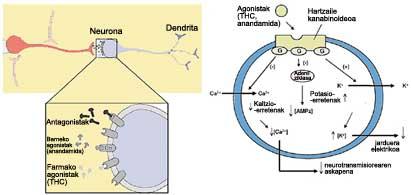
Internal agonists associated with cannabinoid receptors have been found in the last decade. The most important is the so-called anandamide. These molecules, which appear to come from arachidonic acid, have the ability to bind to the CB1 and CB2 receptors. Its functional importance is to be revealed, as they occur in living beings and disappear quickly. It seems that they can allow the release of neurotransmitters and, consequently, modify the temperature, perception (colors, ear, sight, etc. ), cognition (sleep, memory, etc.) and motion control (coordination, muscle tone). Today, once the internal agonists have been found, it would be interesting to know what the function of the cannabinoid system is, since the knowledge of regulation would be important for the healing of certain diseases. Therefore, researchers seek new molecules from the structures of internal agonists.
To make known the whole canabinoid system it is necessary to explain synthetic cannabinoids. In fact, synthetic cannabinoids are more powerful than THC and, thanks to them, research on the cannabinoid system has received a great boost. CB receptors have been classified according to their affinity with certain synthetic cannabinoids. Thus, among the most commonly used in research are the agonists CB1 CP55940 and WIN55212, and the antagonist CB1 SR14176A. In addition, new molecules with greater affinity for CB receptors remain to be discovered.
BIBLIOGRAPHY
Hardman, J.G. and Limbird, L.E.
Goodman Gilman’s
The Pharmacological Basis
Therapeutics.
Ed.
2001 McGraw-Hill,
London.
Howowlett, A. C.; Barth, F.; Free announcement ; Cabral, G.; Casellas, P.; Devane, W.A. ; Felder, C.C. ; Herkenham, M.; Mackie, K.; Martin, B.R. ; Mechoulam, R. and Pertwee, R.G.
International Union of Pharmacology. XXVII. Classification of Cannabinoid Receptors.
2002 Pharmacol Rev; 54 (2): 161-202.
Maldonado, R. and Rodríguez de Fonseca, F.
Cannabinoid addiction; behavioral models and neuronal correlates.
2002 J Neuroscience; 22 (9): 3326-3331.
Pertwee, r.
Cannabinoid receptors. Ed.
1995 Academic press, London.





